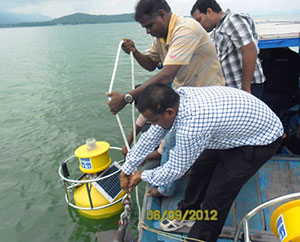Threatened Lake Benefits from Water Quality Monitoring
Researchers in the eastern province of India are hard at work tracking changes in water quality in Chilika Lake, the second-largest estuarine lake in the world. The scientists and government are formulating plans to protect and conserve this hotspot of biodiversity and a Ramsar Convention site.
The highly productive lake ecosystem supports the livelihoods of many fishing communities as well as diverse populations of fish, migratory birds, and aquatic life such as Irrawaddy dolphins and Ridley turtles.
Chilika Lake is a shallow and sensitive ecosystem. A significant amount of freshwater discharges into the lagoon through different rivers and rivulets--bringing sediment with it and affecting depth levels.
At the other end of the lagoon, time and tides from the Bay of Bengal continue to shift and close the narrow strait at the lake’s mouth, affecting salinity levels.
Changing hydrological conditions aren't the only threats to Chilika Lake. The boom in the local fishing industry has also taxed the lake's natural resources. To balance conservation and development in and around the lake, the Indian government created the Chilika Development Authority (CDA) in 1992 to oversee the lake's restoration. In 2000 CDA opened a new mouth to the lake along with several other hydrological interventions, thus improving the lake-sea connection, minimizing sedimentation, and restoring the fishing.
More recently, CDA has developed infrastructure onshore for a wetlands research lab and training center. Offshore, CDA has worked with partners to set up a series of monitoring buoys in different ecological sectors of the lake. The monitoring buoys, equipped with YSI water quality sondes, capture high-resolution data remotely and autonomously. The buoys transmit data telemetrically to the research center. Local personnel have been trained to operate the program and track the physicochemical and biological data.
The YSI monitoring system complements previous water sampling and lab analysis with a move to continuous monitoring. The monitoring system provides a real-time, robust set of high-quality data that directly support the water quality indicators in Chilika Lake’s Ecosystem Health Report Card.
For example, specific salinity concentrations and over-time variations are of great interest to CDA. The varying saline water in the lake’s four sectors creates a suitable habitat for a diverse array of wildlife. Trending salinity data will assist CDA and resource managers in knowing the wetland water characteristics and provide guidance for dredging and maintaining the mouth of the lake, which will increase tidal flushing and maintain optimal levels of salinity.
An electronic copy of Chilika Lake’s Ecosystem Health Report Card and additional information can be found at: www.chilika.com and www.ncscm.org/.

Additional Blog Posts of Interest:
Real-Time Water Quality Monitors Gauge Florida Lagoon's Health
Monitoring Coral Reefs in the Caribbean: Protecting Our Rainforests of the Ocean
Monitoring Wastewater in Hawaii Protects Local Beaches
Keeping Watch on Surging Seas at Dry Tortugas National Park